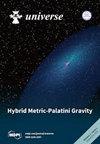用 AXIS 勘测高兹超大质量黑洞的发生与演化
IF 2.5
4区 物理与天体物理
Q2 ASTRONOMY & ASTROPHYSICS
引用次数: 0
摘要
超大质量黑洞(SMBHs)的性质和起源仍然是科学界争论不休的问题。虽然已经提出了各种理论方案,每种方案都有特定的观测特征,但缺乏足够灵敏的 X 射线观测阻碍了观测检验的进展。在本白皮书中,我们将介绍 AXIS 如何为解决这一问题做出贡献。通过轴上 1.5′′′ 的角度分辨率和最小的轴外衰减,我们设计了一种深度巡天观测,能够在大约 700 万秒(7 Ms)的时间内,在 0.13 deg2 的区域内达到 [0.5-2] keV 范围内大约 2 × 10-18 erg s-1 cm-2 的通量极限。此外,我们还计划进行一次中等深度的巡天观测,覆盖面积约为 2 deg2,通量极限约为 2 × 10-17 erg s-1 cm-2,以探测大量 X 射线光度(LX)约为 1042 erg s-1 的 SMBH,直到 z ∼ 10。这些观测将使AXIS能够探测到质量小于105 M⊙的SMBH,假定埃丁顿吸积是有限的,并对II型AGN进行了典型的测光校正。AXIS将提供有关SMBH的种子和种群合成模型的宝贵信息,从而能够更精确地制约它们的初始质量函数(IMF)和z∼0-10的吸积历史。为了实现这一目标,AXIS 将利用 JWST、Roman、Euclid、Vera Rubin 望远镜和新一代 30 米级望远镜等巡天望远镜的独特协同作用。这些仪器将提供光学识别和红移测量,而 AXIS 将发现核活动的 "烟枪",特别是在高度遮蔽的 AGN 或奇特紫外光谱的情况下,正如 JWST 预测和最近在早期宇宙中观测到的那样。本文章由计算机程序翻译,如有差异,请以英文原文为准。
Surveying the Onset and Evolution of Supermassive Black Holes at High-z with AXIS
The nature and origin of supermassive black holes (SMBHs) remain an open matter of debate within the scientific community. While various theoretical scenarios have been proposed, each with specific observational signatures, the lack of sufficiently sensitive X-ray observations hinders the progress of observational tests. In this white paper, we present how AXIS will contribute to solving this issue. With an angular resolution of 1.5′′ on-axis and minimal off-axis degradation, we designed a deep survey capable of reaching flux limits in the [0.5–2] keV range of approximately 2 × 10−18 erg s−1 cm−2 over an area of 0.13 deg2 in approximately 7 million seconds (7 Ms). Furthermore, we planned an intermediate depth survey covering approximately 2 deg2 and reaching flux limits of about 2 × 10−17 erg s−1 cm−2 in order to detect a significant number of SMBHs with X-ray luminosities (LX) of approximately 1042 erg s−1 up to z ∼ 10. These observations will enable AXIS to detect SMBHs with masses smaller than 105 M⊙, assuming Eddington-limited accretion and a typical bolometric correction for Type II AGN. AXIS will provide valuable information on the seeding and population synthesis models of SMBHs, allowing for more accurate constraints on their initial mass function (IMF) and accretion history from z∼0–10. To accomplish this, AXIS will leverage the unique synergy of survey telescopes such as the JWST, Roman, Euclid, Vera Rubin Telescope, and the new generation of 30 m class telescopes. These instruments will provide optical identification and redshift measurements, while AXIS will discover the smoking gun of nuclear activity, particularly in the case of highly obscured AGN or peculiar UV spectra as predicted and recently observed by the JWST in the early Universe.
求助全文
通过发布文献求助,成功后即可免费获取论文全文。
去求助
来源期刊

Universe
Physics and Astronomy-General Physics and Astronomy
CiteScore
4.30
自引率
17.20%
发文量
562
审稿时长
24.38 days
期刊介绍:
Universe (ISSN 2218-1997) is an international peer-reviewed open access journal focused on fundamental principles in physics. It publishes reviews, research papers, communications, conference reports and short notes. Our aim is to encourage scientists to publish their research results in as much detail as possible. There is no restriction on the length of the papers.
 求助内容:
求助内容: 应助结果提醒方式:
应助结果提醒方式:


